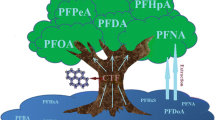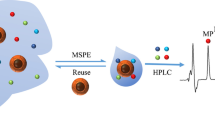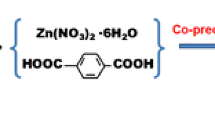Abstract
Magnetic covalent organic frameworks (Fe3O4@TPPCl4) were synthesized via a one-pot process in which magnetic nanoparticles (Fe3O4@MNP) served as a magnetic core and 2,4,6-trihydroxy-1,3,5-benzenetricarbaldehyde (TP) and 2,2′,5,5′-tetrachlorobenzidine (PCl4) as two building blocks to form a shell. The as-prepared Fe3O4@TPPCl4 nanoparticles have superior features, including large surface area (186.5 m2 g−1), high porosity, strong magnetic responsiveness (42.6 emu g−1), high chlorine content, and outstanding thermal stability, which make them an ideal adsorbent for highly selective enrichment of polychlorinated naphthalenes (PCNs). Combining with atmospheric pressure gas chromatography tandem mass spectrometry (APGC-MS/MS), a simple analytical method of Fe3O4@TPPCl4-based magnetic solid-phase extraction (MSPE)-APGC-MS/MS was developed, which exhibited good linearity (r ≥ 0.9991) for eight PCNs in the concentration range 0.1–100 ng L−1. Moreover, low detection limits (0.005–0.325 ng L−1), high enrichment factors (46.62–81.97-fold), and good relative standard deviations (RSDs) of inter-day (n = 3, 1.64 to 7.44%) and day-to-day (n = 3, 2.62 to 8.23%) were achieved. This method was successfully applied to the selective enrichment of PCNs in fine particulate matter (PM)2.5 samples, and ultra-trace PCNs were found in the range 1.56–3.75 ng kg−1 with satisfactory recoveries (93.11–105.81%). The successful application demonstrated the great potential of Fe3O4@TPPCl4 nanoparticles as an adsorbent for enrichment of halogenated compounds.
Graphical abstract

Schematic presented one-pot synthesis of magnetic covalent organic framework nanocomposites (Fe3O4@TPPCl4) and their application in the selective enrichment of PCNs from PM2.5 prior to APGC-MS/MS analysis.






Similar content being viewed by others
References
Yang LL, Zheng MH, Zhu QQ, Yang YP, Li C, Liu GR (2020) Inventory of polychlorinated naphthalene emissions from waste incineration and metallurgical sources in China. Environ Sci Technol 54:842–850. https://doi.org/10.1021/acs.est.9b05539
Zhu QQ, Zhang X, Dong SJ, Gao LR, Liu GR, Zheng MH (2016) Gas and particle size distributions of polychlorinated naphthalenes in the atmosphere of Beijing, China. Environ Pollut 212:128–134. https://doi.org/10.1016/j.envpol.2016.01.065
Li C, Zhang L, Li J, Min YH, Yang LL, Zheng MH, Wu YN, Yang YP, Qin LJ, Liu GR (2019) Polychlorinated naphthalenes in human milk: health risk assessment to nursing infants and source analysis. Environ Int 136:105436. https://doi.org/10.1016/j.envint.2019.105436
Li F, Jin J, Sun XL, Wang XL, Li Y, Shah SM, Chen JP (2014) Gas chromatography-triple quadrupole mass spectrometry for the determination of atmospheric polychlorinated naphthalenes. J Hazard Mater 280:111–117. https://doi.org/10.1016/j.jhazmat.2014.07.060
Pan J, Yang YL, Zhu XH, Leo WYY, Sachi T, Miyake Y, Falandysz J, Yamashita N (2013) Altitudinal distributions of PCDD/Fs, dioxin-like PCBs and PCNs in soil and yak samples from Wolong high mountain area, eastern Tibet-Qinghai Plateau, China. Sci Total Environ 444:102–109. https://doi.org/10.1016/j.scitotenv.2012.11.013
Dat ND, Chang KS, Wu CP, Chen YJ, Tsai CL, Chi KH, Chang MB (2019) Measurement of PCNs in sediments collected from reservoir and river in Northern Taiwan. Ecotoxicol Environ Saf 174:384–389. https://doi.org/10.1016/j.ecoenv.2019.02.087
Mcgoldrick DJ, Pelletier M, de Solla SR, Marvin CH, Martin PA (2018) Legacy of legacies: chlorinated naphthalenes in Lake trout, walleye, herring gull eggs and sediments from the Laurentian Great Lakes indicate possible resuspension during contaminated sediment remediation. Sci Total Environ 634:1424–1434. https://doi.org/10.1016/j.scitotenv.2018.04.077
Xu Y, Li J, Chakraborty P, Syed JH, Malik RN, Wang Y, Tian CG, Luo CL, Zhang G, Jones KC (2014) Atmospheric polychlorinated naphthalenes (PCNs) in India and Pakistan. Sci Total Environ 466:1030–1036. https://doi.org/10.1016/j.scitotenv.2013.07.078
Fernandes AR, Tlustos C, Rose M, Smith F, Carr M, Panton S (2011) Polychlorinated naphthalenes (PCNs) in Irish foods: occurrence and human dietary exposure. Chemosphere 85:322–328. https://doi.org/10.1016/j.chemosphere.2011.06.093
Organtini KL, Haimovici L, Jobst KJ, Reiner EJ, Ladak A, Stevens D, Cochran JW, Dorman FL (2015) Comparison of atmospheric pressure ionization gas chromatography-triple quadrupole mass spectrometry to traditional high-resolution mass spectrometry for the identification and quantification of halogenated dioxins and furans. Anal Chem 87:7902–7908. https://doi.org/10.1021/acs.analchem.5b01705
Li F, Jin J, Tan DQ, Xu JZ, Jai D, Ni YW, Zhang HJ, Chen JP (2016) High performance solid-phase extraction cleanup method coupled with gas chromatography-triple quadrupole mass spectrometry for analysis of polychlorinated naphthalenes and dioxin-like polychlorinated biphenyls in complex samples. J Chromatogr A 1448:1–8. https://doi.org/10.1016/j.chroma.2016.04.037
Siddiqui MF, Khan ZA, Jeon H, Park S (2020) SPE based soil processing and aptasensor integrated detection system for rapid on site screening of arsenic contamination in soil. Ecotoxicol Environ Saf 196:110559. https://doi.org/10.1016/j.ecoenv.2020.110559
Yan XQ, Shen QJ, Zhao XR, Gao HY, Pang X, Jin WJ (2012) Halogen bonding: a new retention mechanism for the solid phase extraction of perfluorinated iodoalkanes. Anal Chim Acta 753:48–56. https://doi.org/10.1016/j.aca.2012.09.024
Xia D, Gao LR, Zheng MH, Wang SS, Liu GR (2016) Simultaneous analysis of polychlorinated biphenyls and polychlorinated naphthalenes by isotope dilution comprehensive two-dimensional gas chromatography high-resolution time-of-flight mass spectrometry. Anal Chim Acta 937:160–167. https://doi.org/10.1016/j.aca.2016.07.018
Yang LL, Liu GR, Zhu QQ, Zheng MH (2019) Small-scale waste incinerators in rural China: potential risks of dioxin and polychlorinated naphthalene emissions. Emerg Contam 5:31–34. https://doi.org/10.1016/j.emcon.2019.01.001
Wang R, Chen ZL (2017) A covalent organic framework-based magnetic sorbent for solid phase extraction of polycyclic aromatic hydrocarbons, and its hyphenation to HPLC for quantitation. Microchim Acta 184:3867–3874. https://doi.org/10.1007/s00604-017-2408-8
Wang M, Gao MJ, Zhang KL, Wang LJ, Wang WC, Fu QF, Xia ZN, Gao D (2019) Magnetic covalent organic frameworks with core-shell structure as sorbents for solid phase extraction of fluoroquinolones, and their quantitation by HPLC. Microchim Acta 186:827. https://doi.org/10.1007/s00604-019-3757-2
Li YJ, Zhou XX, Dong LJ, Lai YJ, Li SS, Liu R, Liu JF (2019) Magnetic metal-organic frameworks nanoparticle for negligible-depletion solid-phase extraction of freely dissolved polyaromatic hydrocarbons. Environ Pollut 252:1574–1581. https://doi.org/10.1016/j.envpol.2019.04.137
Li YX, Zhang HN, Chen YT, Huang L, Lin ZA, Cai ZW (2019) Core-shell structured magnetic covalent organic framework nanoparticle for triclosan and triclocarban adsorption. ACS Appl Mater Interfaces 11:22492–22500. https://doi.org/10.1021/acsami.9b06953
Zhang MY, Li J, Zhong C, Wu ZF, Yang YX, Li JG, Fu FF, Lin ZA (2019) In-situ synthesis of fluorinated magnetic covalent organic frameworks for fluorinated magnetic solid-phase extraction of ultratrace perfluorinated compounds from milk. J Chromatogr A 1615:460773. https://doi.org/10.1016/j.chroma.2019.460773
Chen L, Zhang MY, Fu FF, Li JG, Lin ZA (2018) Facile synthesis of magnetic covalent organic framework nanobeads and application to magnetic solid-phase extraction of trace estrogens from human urine. J Chromatogr A 1567:136–146. https://doi.org/10.1016/j.chroma.2018.06.066
Li C, Li LL, Yang XM, Jin WJ (2017) Halogen bonding-assisted adsorption of iodoperfluoroarenes on a strong anion exchanger and its potential application in solid phase extraction. Colloid Surface A 520:497–504. https://doi.org/10.1016/j.colsurfa.2017.02.016
Zhang MY, Li J, Zhang C, Wu ZF, Yang YX, Li JG, Fu FF, Lin ZA (1615) In-situ synthesis of fluorinated magnetic covalent organic frameworks for fluorinated magnetic solid-phase extraction of ultratrace perfluorinated compounds from milk. J Chromatogr A 2020:460773–460781. https://doi.org/10.1016/j.chroma.2019.460773
Deng H, Li X, Peng Q, Wang X, Chen J, Li YD (2005) Monodisperse magnetic single-crystal ferrite microspheres. Angew Chem Int Ed 44:2782–2785. https://doi.org/10.1002/anie.200462551
Funding
This work was supported by the National Natural Science Foundation of China (91843301, 21974021, and 21705025).
Author information
Authors and Affiliations
Corresponding authors
Ethics declarations
Conflict of interest
The authors declare that they have no competing interests.
Additional information
Publisher’s note
Springer Nature remains neutral with regard to jurisdictional claims in published maps and institutional affiliations.
Supplementary information
ESM 1
(DOCX 3255 kb)
Rights and permissions
About this article
Cite this article
Guo, W., Wang, W., Yang, Y. et al. Facile fabrication of magnetic covalent organic frameworks and their application in selective enrichment of polychlorinated naphthalenes from fine particulate matter. Microchim Acta 188, 91 (2021). https://doi.org/10.1007/s00604-021-04750-z
Received:
Accepted:
Published:
DOI: https://doi.org/10.1007/s00604-021-04750-z




